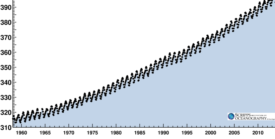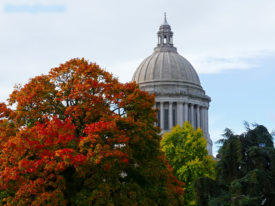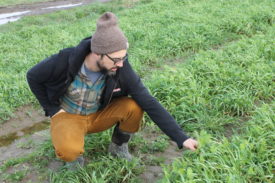Clark:
Chinese architecture student designs a 75 square foot bamboo house –– complete with kitchen, bathroom, laundry, and patio.
The benevolent geniuses over at Walk Score have just released a new tool designed to help city planners figure out whether they’re meeting their walkability goals: ChoiceMaps. In a nutshell, the tool lets you see how many people in your city can walk to schools, grocery stores, restaurants, car/bike shares, or other amenities—and dynamically generates maps of the number of different destinations that residents can choose from, using the most up to date data on the location of each amenity. Planners can use the tool to figure out whether the city is meeting walkability targets—seeing, for example, if there are “food deserts” where city residents can’t walk to a grocery store. But to me, the fascinating thing is to look at the differences among cities. In Seattle, for example, most people are within a 5 minute walk of about 5 restaurants. That’s not bad! Yet in midtown Manhattan, the figure is closer to 85 restaurants—a cornucopia of choices that only a compact urban neighborhood can provide.
For anyone interested in environmental health, here’s a can’t-miss event: an Earth Day celebration for release of Kate Davies’ new book, The Rise of the US Environmental Health Movement. Davies teaches at Antioch University, and her book is, to my knowledge, the first-ever look at the historical roots of a growing social movement that urges North American policymakers to think about the links between environmental quality and human health. The book has its own Facebook page, and Davies will be celebrating the book’s publication on Monday, April 22 (Earth Day) in Seattle, at the iLEAP offices in the Good Shepherd Center in Wallingford. I expect that many of the city’s environmental health luminaries will be on hand to celebrate with her!
Alan:
Sometimes, people ask me how I remain hopeful, given—well—everything. The answer is that action breeds hope. No, action IS hope. And action is breaking out all over the place, as Bill McKibben relates beautifully in his new Rolling Stone piece. “After decades of scant organized response to climate change, a powerful movement is quickly emerging around the country and around the world.”
I’ve been on a John Vaillant tear. I followed his The Golden Spruce (which I sang paeans to in February) with his intriguing story of tigers and the Russian Far East—Cascadia’s distant, dark twin across the Pacific. A more menacing, charismatic, and revealing book of nonfiction I cannot recall. It reflects not just the mirror bioregion to our own but the way big, apex predators have shaped and been shaped by humans, which it casts as the planet’s single most successful scavenger species.
Most recently, touched by the bombings in Boston this week, I read Vaillant’s poignant essay on the one recorded lynching in all of Canadian history, which was perpetrated by a band of Americans who crossed into British Columbia in 1884 and hanged a Sto:lo man named Louie Sam. The tale of Louie Sam’s lynching by vile, cowardly, hate-filled men brought to mind Barry Lopez’s masterful memoir/history of racism in Oregon (pdf). In it he recounts, among other racist atrocities, the rarely discussed mass murder of Deep Creek, on the Oregon side of Hells Canyon. There, in 1887, a band of white men and boys killed in cold blood more than 30 miners of Chinese origin. As in the Sam lynching, authorities never brought any of the perpetrators to justice.
To know this place, and ultimately to redeem it, we must know our history, as hate-filled as some of it is.
Anna:
This is kind of cool. A map of North America’s different accents and linguistic styles. (via David Frum).
Rattles on steroids! What are touchscreens doing to our kids? Hanna Rosin, a correspondent for The Atlantic, digs into what research exists on toddlers and interactive media. She sums up the inner turmoil—that “reluctant zone between denying and giving”—I feel when I hand my smart phone over to my 3 year old:
By their pinched reactions, these parents illuminated for me the neurosis of our age: as technology becomes ubiquitous in our lives, American parents are becoming more, not less, wary of what it might be doing to their children. Technological competence and sophistication have not, for parents, translated into comfort and ease. They have merely created yet another sphere that parents feel they have to navigate in exactly the right way. On the one hand, parents want their children to swim expertly in the digital stream that they will have to navigate all their lives; on the other hand, they fear that too much digital media, too early, will sink them. Parents end up treating tablets like precision surgical instruments, gadgets that might perform miracles for their child’s IQ and help him win some nifty robotics competition—but only if they are used just so. Otherwise, their child could end up one of those sad, pale creatures who can’t make eye contact and has an avatar for a girlfriend.
And, finally, Hendrik Hertzberg’s New Yorker essay exploring how we wound up with the unfortunate word, “entitlements,“—for what should be called something like “social insurance”—is worth a read. Apparently we used to at least say “earned entitlements,” already one step closer to accurate. But, it’s high time for a reframe.










Chris Jones
Alan – If you don’t know about “Deep Creek”, a historical novel by Dana Hand (a pseudonym for a pair of east coast writer/professor/historians), you should take a look. It’s a good read, and it might be right up your alley.